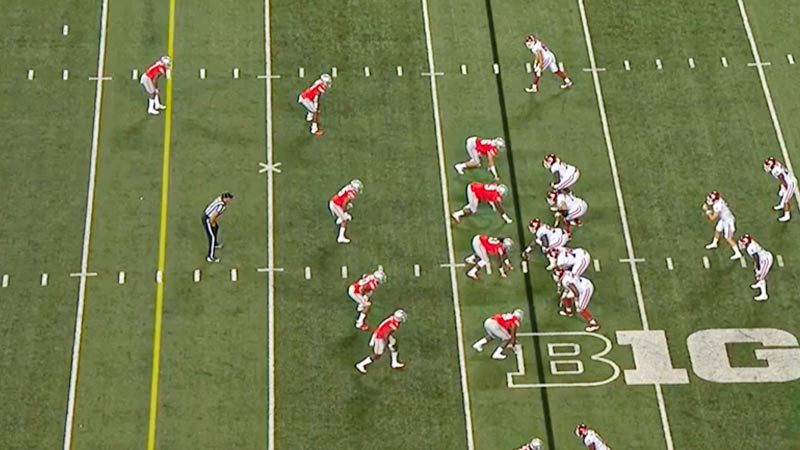Football is a game of strategic chess, with coaches continuously devising innovative tactics to outwit their opponents. Among these tactical marvels stands the “Football Split Back Formation,” a versatile offensive arrangement that has left both fans and defenders guessing for decades.
In this blog post, we dive into the intricacies of the split back formation – its mechanics, benefits, variations, and potential drawbacks.
Whether you’re a devoted football enthusiast or simply intrigued by the strategic aspects of the sport, read on to unravel the secrets behind this formation that have helped shape the game’s dynamic nature. So, stay focused.
What Is a Football Split Back Formation?
The football split back formation entails positioning two running backs on opposing sides of the quarterback, creating a “split” arrangement. This configuration offers versatility in executing both rushing and passing plays.
The strategic advantage lies in the dual threat posed by the two running backs, causing defensive confusion about the intended direction of the play.
With this formation, the offense can effectively execute a variety of plays, keeping the defense off balance and creating opportunities for dynamic offensive maneuvers.
The split back formation is a valuable tool in a team’s playbook, exploiting the dual capabilities of the running backs to create unpredictability and gain an upper hand on the field.
Positions in the Football Split Back Formation
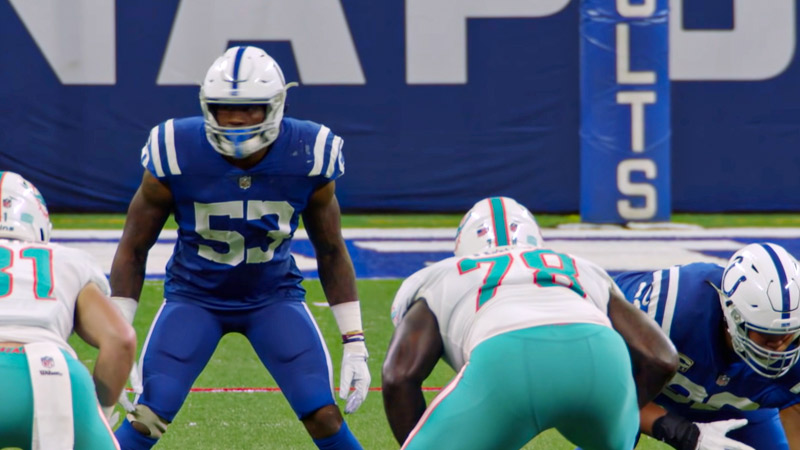
In the football split back formation, there are typically five primary positions on offense, including:
Quarterback (QB)
Positioned directly behind the center, the quarterback initiates the play by receiving the snap from the center. They are responsible for making decisions on whether to hand off the ball, pass, or run based on the defensive alignment.
Fullback (FB)
One of the running backs in the split-back formation, the fullback lines up slightly behind and to the side of the quarterback. The fullback often serves as a blocker, lead blocker for running plays, or even a short-yardage receiving option.
Halfback (HB)
The other running back, or halfback lines up on the opposite side of the quarterback from the fullback. The halfback is often more versatile, capable of running, receiving passes, and occasionally blocking.
Wide Receivers (WR)
Positioned at the edges of the offensive formation, wide receivers are responsible for running routes and catching passes. They stretch the field and can create openings in the defense for passing plays.
Tight End (TE)
Positioned on the offensive line, the tight end can line up on either side of the formation. They contribute to both blocking and receiving, making them versatile assets for a variety of plays.
These positions work together to execute a wide range of plays, making the split back formation effective for both running and passing strategies.
When to Use Football Split Back Formation?
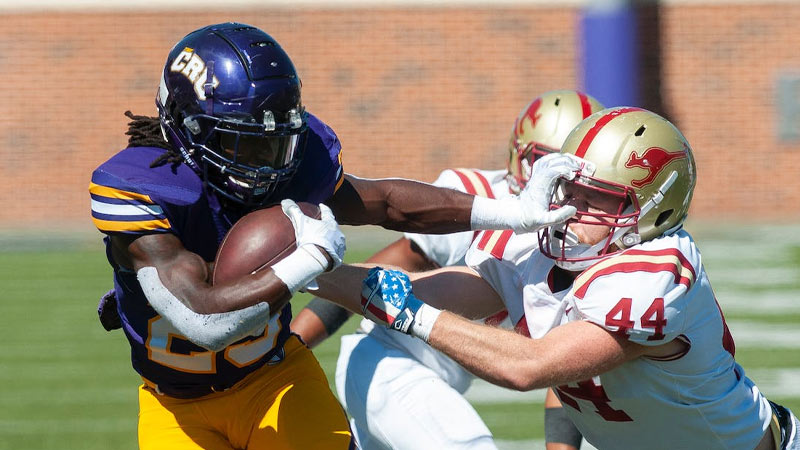
The football split back formation can be strategically employed in various game situations to capitalize on its unique advantages. Here are some scenarios in which the split back formation might be used:
Versatile Running Game
The split back formation is particularly effective for running plays. It allows for diverse running options, such as sweeps, counters, and power runs. This formation can be advantageous in short-yardage situations or when trying to control the clock by running the ball and keeping possession.
Play-Action Passing
The split back formation can set up effective play-action passing plays. With two running backs threatening to run the ball, the defense might be drawn in, creating opportunities for deep passes or passes to the tight end or slot receiver.
Balanced Attack
Teams looking to maintain a balanced offensive attack – mixing run and pass plays – can benefit from the split back formation. It keeps the defense guessing about the type of play and can create mismatches in coverage.
Screen Passes
The presence of two running backs in the split-back formation can help disguise screen passes. The offensive linemen can set up screens while the running backs slip out to receive the pass, potentially gaining significant yardage if the defense is caught off-guard.
Red Zone Situations
In the red zone (close to the opponent’s end zone), the split back formation can create confusion for the defense, leading to successful running or passing plays. The compacted field in this area can make the split back’s deceptive nature even more effective.
Exploiting Matchups
The split back formation can help exploit favorable matchups against linebackers or safeties who might struggle to cover agile running backs in open space.
Two-Minute Drill
In hurry-up situations, the split back formation can be used effectively to quickly move the ball down the field. The running backs can run routes, catch short passes, and gain yards after the catch, helping the offense advance without huddling.
Change of Pace
Switching to the split back formation mid-game can disrupt the defensive game plan and force adjustments, creating an element of surprise and potentially leading to big plays.
Variations in Football Split Back Formation
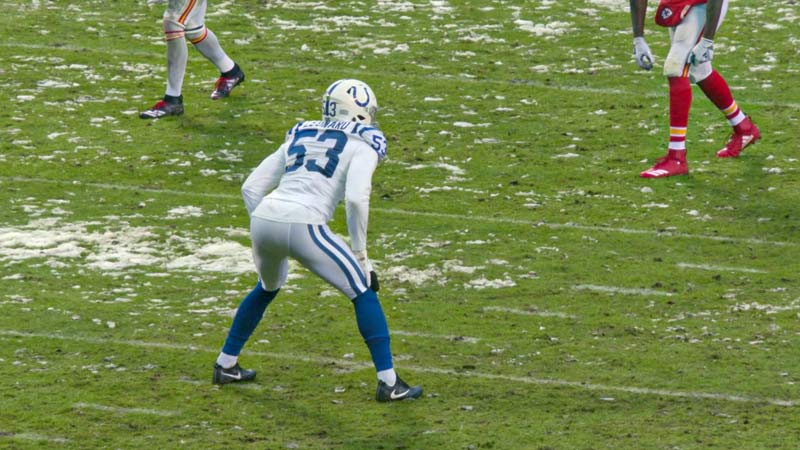
The football split back formation can be adapted and customized with various variations to suit specific offensive strategies, take advantage of player strengths, and create additional complexity for the defense. Here are some common variations:
Double Tight End Split Back Formation
In this variation, an additional tight end lines up on one side of the offensive line. This can enhance blocking for running plays, provide extra protection for the quarterback, and offer additional receiving options.
Empty Backfield Split Back Formation
While the traditional split-back formation features two running backs, the empty backfield variation removes both running backs, leaving only the quarterback and receivers. This formation is designed for passing plays, spreading out the defense, and creating opportunities for quick throws.
Shifts and Motion
Teams can start in a standard split-back formation and then shift into different formations or send a player in motion before the snap. This can help identify defensive coverages, create mismatches, and confuse the defense’s pre-snap reads.
Offset Split Back Formation
One of the running backs is positioned slightly behind and to the side of the quarterback, while the other is on the opposite side. This can create unbalanced offensive formations, potentially leading to advantageous blocking angles or improved passing lanes.
Split Back Shotgun Formation
Instead of having the quarterback under center, this variation places the quarterback in the shotgun position. The running backs still flank the quarterback, providing additional options for quick passes and designed quarterback runs.
Triple Option Split Back Formation
Incorporates an option play where the quarterback can hand off to either running back or keep the ball themselves, adding an extra layer of complexity to the running game.
Passing Play Emphasis
In certain variations, the split back formation can be tailored to emphasize passing plays. The running backs might be utilized more as receivers, running various routes and exploiting matchups against slower linebackers.
Reverses and Trick Plays
The presence of two running backs in the split back formation can set the stage for reverses, end-around, or other trick plays designed to catch the defense off-guard.
No-Huddle Split Back Formation
Implementing the split back formation in a no-huddle offense can create a fast-paced, dynamic attack that prevents the defense from substituting or adjusting effectively.
Formation Shifts
Coaches might employ shifts just before the snap, altering the formation’s look and causing momentary confusion for the defense. These shifts can force the defense to adjust quickly or risk being caught off-balance.
Benefits of Football Split Back Formation
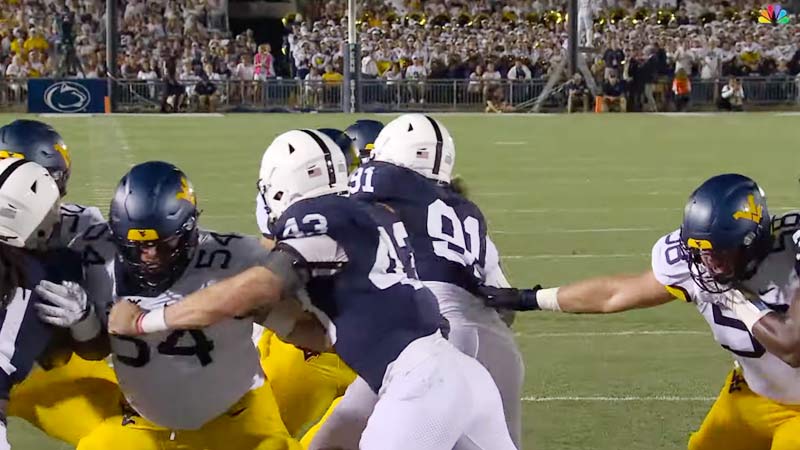
The football split back formation offers several benefits that can be harnessed by offensive teams to gain an edge on the field:
Dual Threat
The presence of two running backs in the backfield creates a dual threat for the defense. This makes it challenging for the defense to anticipate whether the play will be a run or a pass, leading to hesitation and potential mismatches.
Versatility
The formation provides a versatile offensive approach, allowing teams to effectively execute both running and passing plays. This adaptability keeps the defense off balance and prevents them from stacking against a single type of play.
Defensive Confusion
The positioning of two running backs on either side of the quarterback confuses the defense’s assignment responsibilities. Defenders must account for multiple potential ball carriers and receiving options, making it harder for them to react quickly and effectively.
Play-Action Effectiveness
The split back formation sets up play-action passes exceptionally well. With the threat of two running backs in the backfield, defenders are more likely to bite on play fakes, creating windows for downfield passes.
Mismatch Opportunities
Depending on the defensive personnel and alignment, the split back formation can create favorable matchups for both running backs and receivers. These mismatches can be exploited to gain yards and move the chains.
Blocking Options
The formation’s alignment allows for different blocking schemes, making it possible to adjust the blocking assignments based on the defensive front. This can improve protection for the quarterback and open up running lanes.
Red Zone Efficiency
In close proximity to the end zone, the formation’s versatility can lead to effective play-calling. The split back arrangement can create confusion for the defense in confined spaces, potentially resulting in touchdowns.
Screen Plays
The presence of running backs in the backfield makes screen passes more effective. Offensive linemen can set up as blockers while the running backs slip into open space to receive short passes and potentially gain substantial yardage.
Quick Passing Game
The split back formation enables quick, short passing plays. Running backs can be used as outlet options for the quarterback, providing a safety valve against blitzes or tight coverage.
Misdirection and Trickery
The formation’s inherent misdirection potential can be exploited through misdirection plays, reverses, and other trick plays. These tactics keep the defense guessing and create big-play opportunities.
Drawbacks of Football Split Back Formation
While the football split back formation offers numerous advantages, there are also some potential drawbacks and challenges associated with its use:
Pass Protection
The split back formation might not provide as robust pass protection as formations with additional blockers, like the I-formation or single-back formations. The presence of only two running backs could lead to increased vulnerability to blitzes and pressure on the quarterback.
Limited Pass Route Variety
While the split back formation can be effective for play-action passes and quick throws, it might have limitations in terms of complex passing routes. Wide receivers might be the primary downfield targets, potentially making the passing game somewhat predictable.
Predictability
While the formation is designed to be versatile, if not used judiciously, it could become predictable. If the defense anticipates whether a run or pass is likely based on down, distance, and personnel, they can adjust accordingly and mitigate the formation’s effectiveness.
Spacing and Timing
Executing plays effectively in the split back formation requires precise timing and spacing among the quarterback, running backs, and receivers. Mistimed plays or improper spacing could lead to disrupted plays or turnovers.
Running Back Responsibilities
Running backs in the split back formation often have dual responsibilities, requiring them to block, run routes, and carry the ball. This can be mentally and physically demanding and might require running backs with versatile skill sets.
Defensive Keys
Experienced defenders might be able to read the formation and anticipate the play based on pre-snap alignment, potentially limiting the element of surprise.
Limited Short-Yardage Power
While effective for running plays, the split back formation might lack the raw power and push needed for short-yardage situations, such as goal-line situations or third-and-1 situations.
Blocking Challenges
Running backs in the split back formation might need to block in various scenarios, which can be challenging against larger and more powerful defensive linemen or blitzing linebackers.
FAQs
What is the Football Split Back Formation?
The football split back formation features two running backs strategically positioned behind the quarterback, one on each side. This configuration provides a dual threat for running or passing plays, leaving the defense uncertain about the play’s direction.
When is the Split Back Formation Typically Used?
Coaches employ the split back formation in various scenarios, including versatile running plays, play-action passing, red zone situations, and when aiming to exploit favorable matchups. Its adaptability allows for a balanced offensive attack.
What Are the Key Benefits of Using the Split Back Formation?
The split back formation offers benefits such as dual threats, versatility, defensive confusion, effective play-action passing, mismatch opportunities, and the ability to control the clock. It keeps defenses off balance and enhances offensive creativity.
What Are Some Common Variations of the Split Back Formation?
There are several variations of the split back formation, including the double tight end setup, empty backfield, offset alignment, and shotgun variation. These adaptations cater to specific game plans, player strengths, and offensive strategies.
What Challenges or Drawbacks Does the Formation Present?
While the split back formation is advantageous, it can face challenges such as pass protection issues, potential predictability, limited pass route diversity, and personnel constraints. Coaches must manage these factors to maximize their effectiveness.
Wrapping Up
The football split back formation stands as a testament to the intricate and ever-evolving nature of the sport.
From its deceptive potential to its capacity for strategic adaptation, this formation has left an indelible mark on football’s landscape. As teams continue to find innovative ways to deploy this formation, its role in shaping game outcomes remains significant.
Whether in the hands of seasoned coaches or as a source of excitement for fans, the split back formation encapsulates the essence of football’s strategic brilliance. Best of luck.

